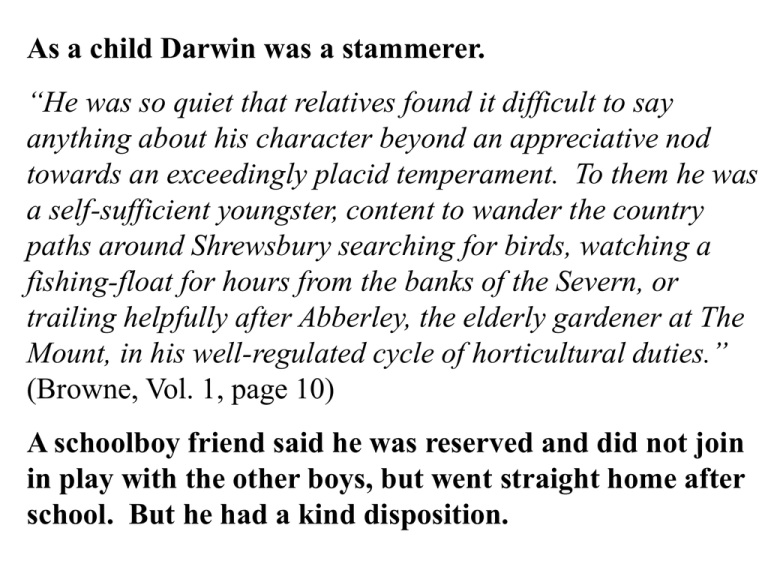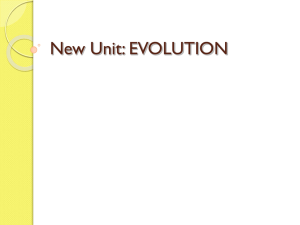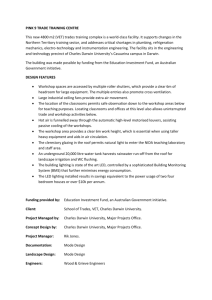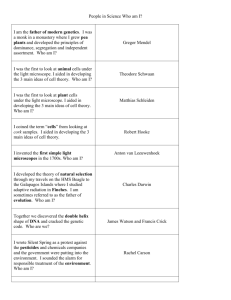PPT - 4 - Darwin before the voyage of the Beagle
advertisement

As a child Darwin was a stammerer. “He was so quiet that relatives found it difficult to say anything about his character beyond an appreciative nod towards an exceedingly placid temperament. To them he was a self-sufficient youngster, content to wander the country paths around Shrewsbury searching for birds, watching a fishing-float for hours from the banks of the Severn, or trailing helpfully after Abberley, the elderly gardener at The Mount, in his well-regulated cycle of horticultural duties.” (Browne, Vol. 1, page 10) A schoolboy friend said he was reserved and did not join in play with the other boys, but went straight home after school. But he had a kind disposition. Darwin particularly liked the outdoors: riding ponies, shooting and fishing, collecting pebbles and plants and birds’ eggs (and, curiously, wax seals on letters). He would go on long, solitary walks. He collected interesting stories and liked to tell anecdotes. He was constantly proposing theories for almost everything which occurred, especially in nature. He was close to his brother Erasmus (five years older than Charles) and to his younger sister Catherine. 1817: In July, at the age of 52, Darwin’s mother Susannah Wedgwood Darwin died. At the age of 8 ½ years Darwin went to “Mr. Case's school," a day-school at Shrewsbury kept by the Rev G. Case, Minister of the Unitarian Chapel. 1818 – 1825 Darwin is sent to Shrewsbury School, a boarding school in the center of town – only 15 minutes away. Shrewsbury school – today an expensive “public” school – was run by the noted classical scholar, Dr. Samuel Butler, grandfather of the writer Samuel Butler (Erewhon, The Way of All Flesh). The school has a top-notch reputation. Of the 54 boys who entered in Darwin’s class of 1818, 12 eventually went to Cambridge and 4 to Oxford; these included most of Darwin’s close friends. One acquaintance was Thomas Butler, the headmaster’s son and father of the writer Samuel Butler. Darwin on Dr. Butler’s School … “Nothing could have been worse for the development of my mind than Dr. Butler’s school, as it was strictly classical, nothing else being taught except a little ancient geography and history. The school as a means of education to me was simply a blank. … Especial attention was paid to verse-making, and this I could never do well. I had many friends, and got together a grand collection of old verses, which by patching together, sometimes aided by other boys, I could work into any subject.” – Autobiography Darwin was quiet, inward-looking, good-natured, according to classmates who remembered him in later years (many didn’t). He was not much interested in his studies, but survived. Rather, he was becoming increasingly interested in natural history, and a busy collector of beetles, butterflies, birds’ eggs, rocks, minerals, etc. He was close to his older brother Erasmus (who attended Shrewsbury School 1815 – 1822), and the two became very interested in chemistry and furnished a small laboratory to carry out experiments; they owned William Henry’s Elements of Experimental Chemistry (1819). “When I left the school I was for my age neither high nor low in it; and I believe that I was considered by all my masters and by my father as a very ordinary boy, rather below the common standard in intellect. To my deep mortification my father once said to me, ‘You care for nothing but shooting, dogs, and rat-catching, and you will be a disgrace to yourself and all your family.’ But my father, who was the kindest man I ever knew and whose memory I love with all my heart, must have been angry and somewhat unjust when he used such words.” – Autobiography Darwin’s father thought long and hard about what might happen to Charles, and what he should do in life. As an unbeliever (though his wife had been a believer) he did not think in terms of Charles becoming a clergyman. Since Charles disliked ancient languages (Latin and Greek) he wouldn’t make a good lawyer. Since he was poor at mathematics, natural philosophy did not seem to be a good choice of a career. But medicine should work out well, and let Charles continue to maintain natural history as a hobby. To Edinburgh University in October 1825 “As I was doing no good at school, my father wisely took me away at a rather earlier age than usual, and sent me (Oct. 1825) to Edinburgh University with my brother, where I stayed for two years or sessions. My brother was completing his medical studies, though I do not believe he ever really intended to practise, and I was sent there to commence them. But soon after this period I became convinced from various small circumstances that my father would leave me property enough to subsist on with some comfort, though I never imagined that I should be so rich a man as I am; but my belief was sufficient to check any strenuous efforts to learn medicine.” – Autobiography Edinburgh University, attended by Darwin 1825-1827. “The instruction at Edinburgh was altogether by lectures, and these were intolerably dull, with the exception of those on chemistry by Hope; but to my mind there are no advantages and many disadvantages in lectures compared with reading. Dr. Duncan's lectures on Materia Medica at 8 o'clock on a winter's morning are something fearful to remember. Dr. Munro made his lectures on human anatomy as dull as he was himself, and the subject disgusted me. It has proved one of the greatest evils in my life that I was not urged to practise dissection, for I should soon have got over my disgust; and the practice would have been invaluable for all my future work. This has been an irremediable evil, as well as my incapacity to draw.” – Autobiography “I also attended regularly the clinical wards in the hospital. Some of the cases distressed me a good deal, and I still have vivid pictures before me of some of them; but I was not so foolish as to allow this to lessen my attendance. I cannot understand why this part of my medical course did not interest me in a greater degree; for during the summer before coming to Edinburgh I began attending some of the poor people, chiefly children and women in Shrewsbury: I wrote down as full an account as I could of the case with all the symptoms, and read them aloud to my father, who suggested further inquiries and advised me what medicines to give, which I made up myself. At one time I had at least a dozen patients, and I felt a keen interest in the work. My father, who was by far the best judge of character whom I ever knew, declared that I should make a successful physician, – meaning by this one who would get many patients. He maintained that the chief element of success was exciting confidence; but what he saw in me which convinced him that I should create confidence I know not.” – Autobiography “I also attended on two occasions the operating theatre in the hospital at Edinburgh, and saw two very bad operations, one on a child, but I rushed away before they were completed. Nor did I ever attend again, for hardly any inducement would have been strong enough to make me do so; this being long before the blessed days of chloroform. The two cases fairly haunted me for many a long year.” – Autobiography Anesthesia is generally considered to have begun with ether in 1846 and chloroform in 1847 – about 20 years after Darwin was at Edinburgh University At Edinburgh, Darwin attended meetings of the Plinian Society and read papers there, becoming a member in November 1826. Some of the papers presented were controversial In February, 1827, a certain Mr. Grey had submitted his theory “that the lower animals possess every faculty and propensity of the human mind,” a point of view to which Darwin subscribed in later years. In March, 1827, a member named W. A. Browne proposed that mind and thus consciousness had an entirely material basis. This was a very unorthodox proposal, and the members found it so offensive and even blasphemous that the Society expunged from its records all trace of the paper and the ensuing discussion, and even Browne’s announcement of this paper at the previous meeting of the society! Darwin was present at this meeting and presumably heard the presentation. Leonard Horner, Lyell’s father-in-law, once took Darwin to a meeting of the Royal Society of Edinburgh, where the famous novelist Sir Walter Scott was presiding: “Sir Walter Scott [sat] in the chair as President, and he apologised to the meeting as not feeling fitted for such a position. I looked at him and at the whole scene with some awe and reverence… If I had been told at that time that I should one day have been thus honoured, I declare that I should have thought it as ridiculous and improbable, as if I had been told that I should be elected King of England.” “By the way, a Negro lived in Edinburgh, who had travelled with Waterton, and gained his livelihood by stuffing birds, which he did excellently: he gave me lessons for payment, and I used often to sit with him, for he was a very pleasant and intelligent man.” – Autobiography Waterton was Charles Waterton (1782-1865), a noted (and eccentric) naturalist and expert taxidermist who had visited South America and written about it. The Negro is known to have been John Edmonstone, a freed slave originally from Guyana, who had been taught taxidermy by Waterton. Burke and Hare By leaving the medical school at Edinburgh University in the fall of 1827, Charles Darwin just missed being there during the infamous Burke and Hare “body-snatching” episode of November 1827 to November 1828. William Burke and William Hare, who lived in Edinburgh, discovered that the medical school would pay up to £15 for fresh cadavers for medical students to use in their studies. They sold about 17 cadavers to Robert Knox, lecturer in anatomy at Edinburgh, some of them old persons who had died but most of them persons (old persons, prostitutes, etc.) they had murdered. They were found out in November 1828. “Burke the Butcher, Hare the Thief, Knox the boy who buys the beef.” Burke was tried, convicted, and sentenced to death. He was hanged on January 28,1829. Hare was given immunity for testifying against Burke and was released in February 1829 and disappeared from the history books. Robert Knox was not prosecuted because there was no evidence that he knew that Burke and Hare were killing to secure the corpses, but his career was ruined and he was dismissed from the University, eventually becoming a doctor in London. Knox had a young assistant, Thomas Wharton-Jones, whose career was not affected by the Burke-Hare affair. He would later exert a powerful positive influence on Thomas H. Huxley. 1828: Began residence at Christ's College, Cambridge. “I went to Cambridge early in the year 1828, and soon became acquainted with Professor [John Stevens] Henslow...Nothing could be more simple, cordial and unpretending than the encouragement which he afforded to all young naturalists.” “During the three years which I spent at Cambridge my time was wasted, as far as the academical studies were concerned, as completely as at Edinburgh and at school.” Christ’s College, Cambridge, attended by Darwin 1828-1831. Darwin’s room at Christ’s College, Cambridge (1909 photo). “I attempted mathematics, and even went during the summer of 1828 with a private tutor (a very dull man) to Barmouth, but I got on very slowly. The work was repugnant to me, chiefly from my not being able to see any meaning in the early steps in algebra. This impatience was very foolish, and in after years I have deeply regretted that I did not proceed far enough at least to understand something of the great leading principles of mathematics, for men thus endowed seem to have an extra sense. But I do not believe that I should ever have succeeded beyond a very low grade.” – Darwin’s Autobiography John Stevens Henslow (1796 – 1861) A very popular professor of mineralogy and of botany at Cambridge, and also a clergyman. He had a tremendous influence on Darwin’s development as a naturalist (recommending him for the naturalist position on the Beagle, for instance). Adam Sedgwick (1785 – 1873) One of the founders of modern geology. The Woodwardian Professor of Geology at Cambridge from 1818 to his death 55 years later in 1873. Worked on (and proposed) Devonian and Cambrian periods. Charles Darwin was one of Sedgwick’s geology students, and the two were close friends for nearly half a century, until Sedgwick’s death in 1873 at the age of 88. Sedgwick was a catastrophist and believed that God was continually creating throughout history. He was a very religious man, though not a fundamentalist as the term is understood today. He strongly opposed Darwin’s theory of evolution and attacked his books: “It repudiates all reasoning from final causes; and seems to shut the door on any view (however feeble) of the God of Nature as manifested in His works. From first to last it is a dish of rank materialism cleverly cooked and served up.” Yet they remained friends! 1831: “In order to pass the B.A. Examination, it was...necessary to get up [William] Paley's ‘Evidences of Christianity’ and his ‘Moral Philosophy’ ... The careful study of these works, without attempting to learn any part by rote, was the only part of the academical course which...was of the least use to me in the education of my mind." Darwin passed the examination for the B.A. degree in January. “I gained a good place among the oi polloi or crowd of men who do not go in for honours.” William Paley (1743 – 1805) Noted Anglican clergyman, writer and philosopher; Archdeacon of Carlisle. Major books: Principles of Moral and Political Philosophy View of the Evidences of Christianity Natural Theology William Paley’s Natural Theology; or, Evidences of the Existence and Attributes of the Deity (1802) A well-written, easy-to-read book on “natural theology” (as opposed to “revealed theology”), more or less what is now referred to as “intelligent design.” It popularized the Watchmaker Analogy still discussed today. “I am convinced that I could have written out the whole of the 'Evidences' with perfect correctness, but not of course in the clear language of Paley. The logic of this book and, as I may add, of his 'Natural Theology,' gave me as much delight as did Euclid. … I did not at that time trouble myself about Paley's premises; and taking these on trust, I was charmed and convinced by the long line of argumentation.” – Darwin’s Autobiography The first sentences of Paley’s Natural Theology: “In crossing a heath, suppose I pitched my foot against a stone, and were asked how the stone came to be there; I might possibly answer, that, for any thing I knew to the contrary, it had lain there for ever: nor would it perhaps be very easy to show the absurdity of this answer. But suppose I had found a watch upon the ground, and it should be inquired how the watch happened to be in that place; I should hardly think of the answer which I had before given, that, for any thing I knew, the watch might have always been there. Yet why should not this answer serve for the watch as well as for the stone? why is it not as admissible in the second case, as in the first? … continued “For this reason, and for no other, viz. that, when we come to inspect the watch, we perceive (what we could not discover in the stone) that its several parts are framed and put together for a purpose, e. g. that they are so formed and adjusted as to produce motion, and that motion so regulated as to point out the hour of the day; that, if the different parts had been differently shaped from what they are, of a different size from what they are, or placed after any other manner, or in any other order, than that in which they are placed, either no motion at all would have been carried on in the machine, or none which would have answered the use that is now served by it.” David Hume (1711 – 1776) Scottish historian and philosopher Well-known atheist; did not give “miracles” much credit. Posthumously-published Dialogues Concerning Natural Religion has three persons arguing about the existence of God, especially the argument from design, to which one person (Philo – presumably Hume) gives counterarguments, including one that is suggestive of natural selection. Dialogues Concerning Natural Religion Philo is apparently the speaker representing Hume’s thoughts. At one point he says, “But were this world ever so perfect a production, it must still remain uncertain, whether all the excellences of the work can justly be ascribed to the workman. If we survey a ship, what an exalted idea must we form of the ingenuity of the carpenter who framed so complicated, useful, and beautiful a machine? And what surprise must we feel, when we find him a stupid mechanic, who imitated others, and copied an art, which, through a long succession of ages, after multiplied trials, mistakes, corrections, deliberations, and controversies, had been gradually improving? continued … Hume continued … “Many worlds might have been botched and bungled, throughout an eternity, ere this system was struck out; much labour lost, many fruitless trials made;and a slow, but continued improvement carried on during infinite ages in the art of world-making. In such subjects, who can determine, where the truth; nay, who can conjecture where the probability lies, amidst a great number of hypotheses which may be proposed, and a still greater which may be imagined?” Hume continued … “It is observed by arithmeticians, that the products of 9, compose always either 9, or some lesser product of 9, if you add together all the characters of which any of the former products is composed. Thus, of 18, 27, 36, which are products of 9, you make 9 by adding 1 to 8, 2 to 7, 3 to 6. Thus, 369 is a product also of 9; and if you add 3, 6, and 9, you make 18, a lesser product of 9. To a superficial observer, so wonderful a regularity may be admired as the effect either of chance or design: but a skillful algebraist immediately concludes it to be the work of necessity, and demonstrates, that it must for ever result from the nature of these numbers. . . .” Hume continued … “ . . . Is it not probable, I ask, that the whole economy of the universe is conducted by a like necessity, though no human algebra can furnish a key which solves the difficulty? And instead of admiring the order of natural beings, may it not happen, that, could we penetrate into the intimate nature of bodies, we should clearly see why it was absolutely impossible they could ever admit of any other disposition? So dangerous is it to introduce this idea of necessity into the present question! and so naturally does it afford an inference directly opposite to the religious hypothesis!” The Bridgewater Treatises (1833 – 1840) Eight treatises published between 1833 and 1840 stating the case for “natural theology.” Funded in 1829 by an 8,000-pound-sterling grant to the Royal Society of London by Francis Henry Egerton, the 8th Earl of Bridgewater, given to publish works “On the Power, Wisdom, and Goodness of God, as Manifested in the Creation.” Authors: Thomas Chalmers (mathematician, clergyman), John Kidd (medical doctor, chemist, geologist), William Whewell (scientist and clergyman and historian of science), Sir Charles Bell (surgeon and physiologist), Peter Mark Roget (physician and thesaurus author), William Buckland (geologist), William Kirby (1759-1850, “father of entomology”), William Prout (medical doctor and chemist, author of “Prout’s hypothesis”). The Ninth Bridgewater Treatise Written in the 1830s by Charles Babbage, the Lucasian Professor of Mathematics at Cambridge. He argued that God the Creator had not created species, but laws (or programs), like a legislator, and that these laws produced new species at the appropriate time, making ad hoc miracles of special creation unnecessary. Charles Babbage . . . Babbage drew up plans for mechanical calculators and started construction of some, always thinking of improvements. None were finished until after his death, when it was found that they worked fine. They included a difference engine and an “Analytical Engine” that would be programmable and had many features of modern computers. Babbage intensely disliked organ grinders and other street noise-makers, and wrote tracts against them. He also made a study of the ways in which warehouse windows were broken. In 1842 Alfred Tennyson published a new poem, "The Vision of Sin," which included the line “Every moment dies a man, /Every moment one is born.” Babbage wrote him a letter praising the poem, but suggesting that this line needed to be corrected. “It must be manifest that, were this true, the population of the world would be at a standstill,” Babbage pointed out, but, since the human population was growing slowly, “I would suggest that in the next edition of your poem you have it read: ‘Every moment dies a man,/Every moment 11/16 is born.’ ” This was not quite correct, Babbage admitted, “but I believe 1-1/16 will be sufficiently accurate for poetry.” “Creationists” There have always been different types of “creationists” who regarded the universe as being created by God. “Young-earth creationists” believed God created the earth about 6000 years ago, based on the chronology of the Bible. “Old-earth creationists” believed God created the earth all at once millions or billions of years ago. Some biologists and geologists before Darwin believed there had been several or even many creations, with destructions of all life from time to time. Some scientists, like Babbage and many today, thought God had only created the laws of nature, setting things in motion. A Modern Creationist Kurt Wise was raised as a religious fundamentalist and creationist; he studied paleontology and earned a Ph. D. from Harvard University, where Stephen Jay Gould was one of his teachers. “Creation isn’t a theory. The fact that God created the universe is not a theory – it’s fact. However, some of the details are not specifically nailed down in Scripture. Some issues – such as creation, a global flood, and a young age for the earth – are determined by Scripture, so they are not theories. My understanding from Scripture is that the universe is in the order of 6,000 years old. Once that has been determined by Scripture, it is a starting point that we build theories upon.”






